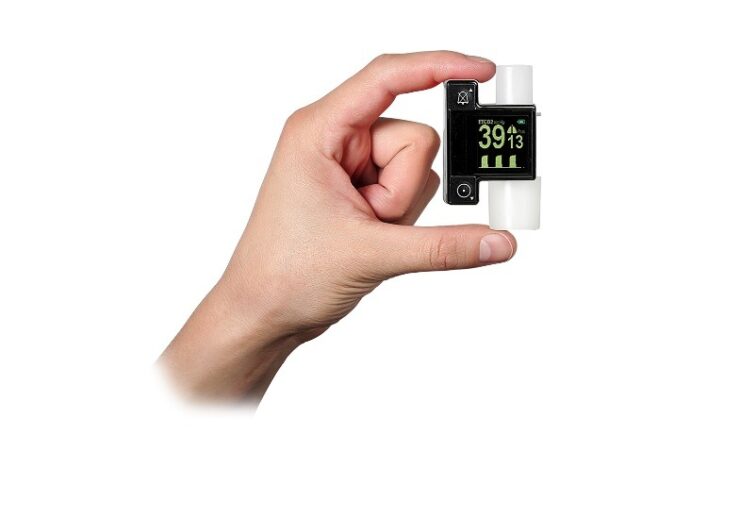The device requires no routine calibration and minimal warm-up time, with accurate end-tidal carbon dioxide (EtCO2) and respiration rate measurements and continuous EtCO2 waveforms displayed within 15 seconds

Masimo EMMA Capnograph. (Credit: Masimo)
Masimo (NASDAQ: MASI) today announced the findings of an observational, retrospective study published in Pediatrics International. In the study, researchers at the Osaka Women’s and Children’s Hospital in Japan found the Masimo EMMA® Portable Capnograph “useful for assessment of the respiratory condition in children with tracheostomy.”1 EMMA provides seamless mainstream capnography for patients of all ages in a compact, easily portable device. The device requires no routine calibration and minimal warm-up time, with accurate end-tidal carbon dioxide (EtCO2) and respiration rate measurements and continuous EtCO2 waveforms displayed within 15 seconds.
Noting the potential value of a compact and portable way to monitor changes in respiratory status for patients in scenarios where typical inpatient hospital monitoring equipment is less likely to be available, Dr. Masashi Hotta and colleagues sought to evaluate the utility of the EMMA capnograph on children with tracheostomy by comparing EtCO2 values from the EMMA device (which was connected to the distal side of the tracheostomy cannula) to invasively measured partial pressure of venous carbon dioxide (PvCO2). Although partial pressure of arterial carbon dioxide (PaCO2) is considered a gold standard for assessing respiratory condition, the researchers chose PvCO2 because “collection of arterial samples is more invasive than collection of venous samples” and noted that studies have shown a correlation between PaCO2 and PvCO2.2,3 They enrolled 9 infants (median age 8 months) and compared 43 paired EtCO2–PvCO2 readings in total.
The researchers found a correlation coefficient of 0.87 (95% confidence interval of 0.7 – 0.93; p < 0.001) between EtCO2 and PvCO2 readings. Analysis of the data revealed that EtCO2 readings were, on average, 10.0 mmHg lower than the corresponding paired PvCO2 value (95% limits of agreement of 1.0 – 19.1 mmHg). The researchers speculated that the tendency for EtCO2 to be lower than PvCO2 may be explained by “gas mixing proximal to the tracheostomy cannula due to the presence of anatomic and physiologic dead space. Because almost all patients used a cannula without a cuff, some air leakage may have occurred. In addition, about two-thirds of the patients had [chronic lung disease or bronchopulmonary dysplasia],” which they noted have been shown to cause lower CO2 concentrations during exhalation, relative to the partial pressure of CO2 in the blood.
They also found that the median difference in values was significantly greater for readings collected while patients were on mechanical ventilation (28 of the 43 data pairs). With a ventilator, there was a median 11.2 mmHg (6.8 – 14.3) difference; without a ventilator, there was a median 6.6 mmHg (4.1 – 9.0) difference (p = 0.043). The researchers noted that use of a ventilator was significantly related to the difference in paired readings because patients on ventilators had respiratory or circulatory disease.
Noting that “We demonstrated a strong positive relationship between PvCO2 and EtCO2 and revealed the availability and usefulness of this capnometer for children with tracheostomy,” the researchers concluded, “EMMA is useful for assessment of the respiratory condition in children with tracheostomy. EMMA can be used especially in home-care settings and outpatient departments for such children.” They also noted, “The main strength of this study is that we used a portable capnometer to evaluate EtCO2.”
Source: Company Press Release
